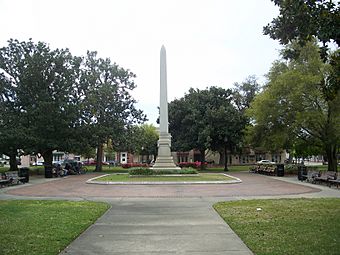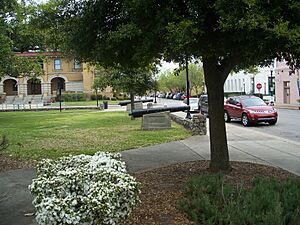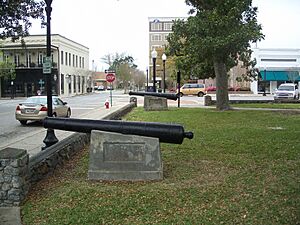Plaza Ferdinand VII facts for kids
|
Plaza Ferdinand VII
|
|

The plaza, with the Chipley monument in the center
|
|
| Location | Pensacola, Florida, USA |
|---|---|
| Area | 2 acres (0.81 ha) |
| NRHP reference No. | 66000264 |
Quick facts for kids Significant dates |
|
| Added to NRHP | October 15, 1966 |
| Designated NHL | October 9, 1960 |

The Plaza Ferdinand VII is a special outdoor park in downtown Pensacola, Florida. It's part of the Historic Pensacola Village area. You can find it on Palafox Street, between Government and Zaragoza Streets.
This park is named after Ferdinand VII of Spain, who was the King of Spain a long time ago, from 1813 to 1833. It's a very important historical spot. In 1821, Florida officially became part of the United States right here!
Contents
Discovering Plaza Ferdinand VII
Plaza Ferdinand VII is a green, open space that covers about 2 acres (0.8 hectares). It has lots of trees and paved paths for walking. The park is surrounded by streets: Government Street to the north, Jefferson Street to the east, Zaragoza Street to the south, and Palafox Street to the west.
There are three main things to see in the plaza. Near the north end, you'll find a pretty fountain. In the very middle, there's a tall, pointed monument called an obelisk. This obelisk honors William Dudley Chipley, who was important in building railroads and was once the mayor of Pensacola. Closer to the south end, there's a special memorial for Andrew Jackson.
This park is part of a city plan that was first made in 1765. Back then, Pensacola was the capital of a British colony called West Florida. The original park was a bit bigger, but some parts were sold off in 1802 when the area was under Spanish rule again.
Florida's Transfer to the U.S.
The Plaza Ferdinand VII is famous for a big historical event. In 1819, Spain and the United States made a deal called the Adams–Onís Treaty. In this treaty, Spain agreed to give Florida to the United States. The treaty became official in 1821.
In March 1821, Andrew Jackson was chosen to be Florida's first governor. His job was to make sure the transfer of Florida from Spanish control to the United States went smoothly. There was a ceremony in St. Augustine on July 10, but the main event happened here in Pensacola.
On July 21, 1821, a special ceremony took place at this very plaza. The Spanish flag was lowered, and the American flag was raised. Andrew Jackson gave a speech to everyone there. He told them that Florida was now a U.S. territory, and Pensacola would be its capital city. The bust (a statue of his head and shoulders) of Andrew Jackson that you see in the plaza today marks the exact spot where he became the governor. The Pensacola Historic Preservation Society gave this bust to the park in 1935.
Because of its important history, Plaza Ferdinand VII was named a National Historic Landmark in 1960. This means it's a place recognized for its special historical value to the entire country. It was also added to the National Register of Historic Places in 1966.
New Year's Fun at the Plaza
Plaza Ferdinand VII is not just for history! It's also the place where the Pelican Drop happens. This is a fun New Year's Eve celebration in Pensacola.
Buildings Near the Plaza
There are some interesting buildings close to Plaza Ferdinand VII:
- The Saenger Theatre is a beautiful old theater.
- The Quayside Art Gallery is located in an old firehouse from 1873. You can find it at 17 E. Zaragoza Street.
- The Federalist House is another historic building at 11 E. Zaragoza Street.





